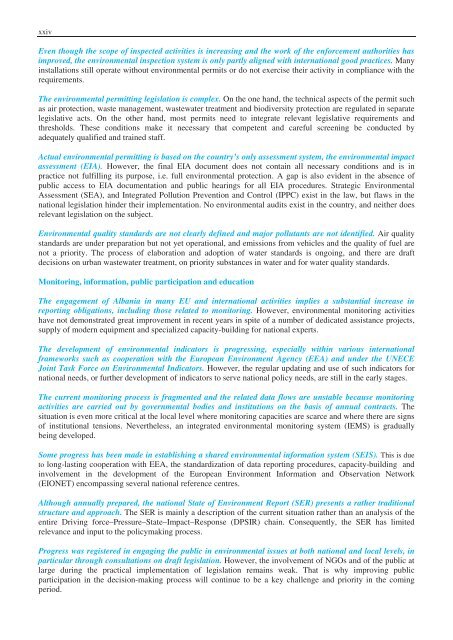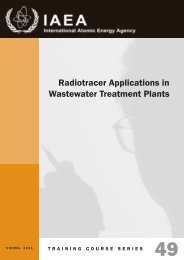Second Environmental Performance Review of Albania
Second Environmental Performance Review of Albania
Second Environmental Performance Review of Albania
You also want an ePaper? Increase the reach of your titles
YUMPU automatically turns print PDFs into web optimized ePapers that Google loves.
xxivEven though the scope <strong>of</strong> inspected activities is increasing and the work <strong>of</strong> the enforcement authorities hasimproved, the environmental inspection system is only partly aligned with international good practices. Manyinstallations still operate without environmental permits or do not exercise their activity in compliance with therequirements.The environmental permitting legislation is complex. On the one hand, the technical aspects <strong>of</strong> the permit suchas air protection, waste management, wastewater treatment and biodiversity protection are regulated in separatelegislative acts. On the other hand, most permits need to integrate relevant legislative requirements andthresholds. These conditions make it necessary that competent and careful screening be conducted byadequately qualified and trained staff.Actual environmental permitting is based on the country’s only assessment system, the environmental impactassessment (EIA). However, the final EIA document does not contain all necessary conditions and is inpractice not fulfilling its purpose, i.e. full environmental protection. A gap is also evident in the absence <strong>of</strong>public access to EIA documentation and public hearings for all EIA procedures. Strategic <strong>Environmental</strong>Assessment (SEA), and Integrated Pollution Prevention and Control (IPPC) exist in the law, but flaws in thenational legislation hinder their implementation. No environmental audits exist in the country, and neither doesrelevant legislation on the subject.<strong>Environmental</strong> quality standards are not clearly defined and major pollutants are not identified. Air qualitystandards are under preparation but not yet operational, and emissions from vehicles and the quality <strong>of</strong> fuel arenot a priority. The process <strong>of</strong> elaboration and adoption <strong>of</strong> water standards is ongoing, and there are draftdecisions on urban wastewater treatment, on priority substances in water and for water quality standards.Monitoring, information, public participation and educationThe engagement <strong>of</strong> <strong>Albania</strong> in many EU and international activities implies a substantial increase inreporting obligations, including those related to monitoring. However, environmental monitoring activitieshave not demonstrated great improvement in recent years in spite <strong>of</strong> a number <strong>of</strong> dedicated assistance projects,supply <strong>of</strong> modern equipment and specialized capacity-building for national experts.The development <strong>of</strong> environmental indicators is progressing, especially within various internationalframeworks such as cooperation with the European Environment Agency (EEA) and under the UNECEJoint Task Force on <strong>Environmental</strong> Indicators. However, the regular updating and use <strong>of</strong> such indicators fornational needs, or further development <strong>of</strong> indicators to serve national policy needs, are still in the early stages.The current monitoring process is fragmented and the related data flows are unstable because monitoringactivities are carried out by governmental bodies and institutions on the basis <strong>of</strong> annual contracts. Thesituation is even more critical at the local level where monitoring capacities are scarce and where there are signs<strong>of</strong> institutional tensions. Nevertheless, an integrated environmental monitoring system (IEMS) is graduallybeing developed.Some progress has been made in establishing a shared environmental information system (SEIS). This is dueto long-lasting cooperation with EEA, the standardization <strong>of</strong> data reporting procedures, capacity-building andinvolvement in the development <strong>of</strong> the European Environment Information and Observation Network(EIONET) encompassing several national reference centres.Although annually prepared, the national State <strong>of</strong> Environment Report (SER) presents a rather traditionalstructure and approach. The SER is mainly a description <strong>of</strong> the current situation rather than an analysis <strong>of</strong> theentire Driving force–Pressure–State–Impact–Response (DPSIR) chain. Consequently, the SER has limitedrelevance and input to the policymaking process.Progress was registered in engaging the public in environmental issues at both national and local levels, inparticular through consultations on draft legislation. However, the involvement <strong>of</strong> NGOs and <strong>of</strong> the public atlarge during the practical implementation <strong>of</strong> legislation remains weak. That is why improving publicparticipation in the decision-making process will continue to be a key challenge and priority in the comingperiod.
















